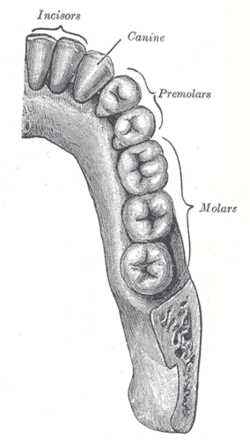Human Anatomy
- Maxillary first premolar
- Maxillary second premolar
- Mandibular first premolar
- Mandibular second premolar
- Premolar teeth are permanent teeth distal to the canines, preceded by deciduous molars.
Morphology
- Premolars have one large buccal cusp, especially in the mandibular first premolar.
- The lower second premolar usually has two lingual cusps.
- The lower premolars and the upper second premolar usually have one root.
- The upper first premolar usually has two roots, but can have just one or three roots.
- Premolars are referred to as bicuspid, with a buccal and a palatal/lingual cusp separated by a mesiodistal occlusal fissure.
Maxillary Premolars
- Maxillary First Premolar:
- Crown appears ovoid, wider buccally than palatally.
- Similar to adjacent canine from a buccal view.
- Roots: Two roots buccal and palatal, sometimes only one root.
- Maxillary Second Premolar:
- Similar to maxillary first premolar, but with rounder mesio-buccal and disto-buccal corners.
- Two cusps are smaller and more equal in size.
- Shorter occlusal fissure.
- Usually one root.
Mandibular Premolars
- Mandibular First Premolar:
- Smallest premolar out of all four.
- Dominant buccal cusp and a very small lingual cusp.
- Two-thirds of the buccal surface can be seen from the occlusal aspect.
- Single conical root with an oval/round cross-section, grooved longitudinally mesially and distally.
Orthodontics and Other Mammals
- Orthodontics:
- Four first premolars are the most commonly removed teeth in orthodontic treatment.
- Removal of only the maxillary first premolars is the second likeliest option.
- Premolar extraction therapy was initially contested in the orthodontic field.
- Patient reports of health consequences due to extraction/retraction have sparked debate.
- More orthodontists are now avoiding extraction therapy, with a current official rate of 25%.
- Other Mammals:
- Primitive placental mammals have four premolars per quadrant, but the most mesial two have been lost in catarrhines.
- Paleontologists refer to human premolars as Pm3 and Pm4.
- Weiss and Mann (1985) and Warwick and Williams (1973) provide further information on premolars in mammals.
- Standring (2015) discusses the anatomical basis of premolars in humans.
- Kimura et al. (2009) identify a genetic determinant of shovel-shaped incisors in humans.
Merriam-Webster Online Dictionary
premolar (
adjective)
situated in front of or preceding the molar teeth , especially being or relating to those teeth of a mammal in front of the true molars and behind the canines when the latter are present
The premolars, also called premolar teeth, or bicuspids, are transitional teeth located between the canine and molar teeth. In humans, there are two premolars per quadrant in the permanent set of teeth, making eight premolars total in the mouth. They have at least two cusps. Premolars can be considered transitional teeth during chewing, or mastication. They have properties of both the canines, that lie anterior and molars that lie posterior, and so food can be transferred from the canines to the premolars and finally to the molars for grinding, instead of directly from the canines to the molars.
English
Etymology
pre- + molar
Pronunciation
Noun
premolar (plural premolars)
- A tooth situated in front of the molar teeth; especially a tooth in humans with two cusps which is between the canines and the molars (Latin: singular dens premolaris, plural dentes premolares)
...
Read More

